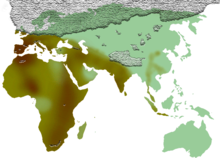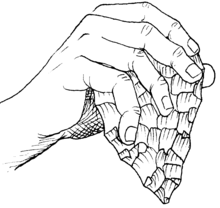Hand ax

The hand ax is a two-sided stone tool and is therefore also known as a two-sided (French: biface ). Hand axes have a round base, the opposite side is pointed. While they were initially very large (> 20 cm), they became smaller in later periods of time. Processing also became more complex.
Hand axes are the main form of the Acheuleans , which began in Africa about 1.75 million years ago . After the choppers and chopping tools of the Oldowan culture, which are more than two million years old , hand axes are the oldest known tools of the homo genus . As the first manufacturer to concurrently existing in East Africa come Hominini - species Homo habilis and Homo rudolfensis and Homo ergaster and Homo erectus in question. In Eurasia , hand axes were only detected much later, about 600,000 years ago more frequently - for Homo heidelbergensis . The Neanderthals and the anatomically modern man ( Homo sapiens ), who have been fossilized for about 200,000 years in Africa, also used hand axes until about 40,000 years ago.
For what purpose the hand axes of the Acheuleans in particular - around 1.5 million years in largely the same form - were made, "is uncertain."
classification
Hand axes are usually oval to pear-shaped. The average length of the hand axes is 100 to 250 millimeters, but there are also much larger examples. The material used was mainly very fine-grained rocks with a high quartz content such as quartzite and volcanite , less often flint and other pebbles such as chert and obsidian . Are extremely rare finds from bone , such as the mammoth - hand ax from Rhede , exhibited in the LWL Museum of Archeology .
There are so-called hand ax industries that have produced concise shapes and processing methods and were used to classify the oldest human cultures: Abbevillians , also called Chelléen (600,000 to 400,000 years ago), Acheuléen (up to 150,000 years ago), Micoquien (130,000 to 70,000 years ago) and Moustérien (120,000 to 40,000 years ago), all named after sites in France. However, it cannot be clearly proven whether these different forms actually hide different archaeological cultures or even different types of people.
Their distribution in Central Europe is an extension of the extremely rich occurrences in Western Europe. The limit of the hand axes of the Acheuléen lies on the Oder . Only late hand ax forms and related devices of the Micoquien, which are slammed on both sides, are also widespread in Eastern Central Europe and Eastern Europe.
distribution

Hand axes were very common. The simplest and oldest forms were found in Africa . The currently most ancient finds of hand axes worked on both sides are assigned to an age of 1.75 million years. There are only very few finds east of the so-called Movius Line , in Southeast Asia and China. This can be explained by a research gap, a lack of raw materials and suitable alternative material such as bamboo.
The oldest European hand axes in the Mediterranean area are documented about 900,000 years ago, north of the Alps, however, earliest about 600,000 years ago ( Boxgrove Quarry site ).
The hand axes of the Acheuléen, which have been attributed to Homo ergaster / Homo erectus for thousands of years, were made for around 1.5 million years in the entire distribution area according to the same pattern. Smaller regional variants can be traced back to the different parent rock, so they are not considered evidence of intentional changes.
See also
literature
- Jean-Marie Le Tensorer : Hand axes . In: H. Floss (Hrsg.): Stone artifacts from the Old Palaeolithic to the modern age . 2nd Edition. Tübingen 2013, ISBN 978-3-935751-16-2 , pp. 209-218.
- K. Kuman, AS Field: The Oldowan Industry from Sterkfontein: raw materials and core forms. In: R. Soper / G. Pwiti (Ed.): Aspects of African Archeology. Papers from the 10th Congress of the Pan-African Association for Prehistory and Related Studies. Univ. of Zimbabwe Publications (Harare 1996), pp. 139-146 ( online , PDF).
- José M. Merino: Tipología lítica. Editorial Munibe 1994. Suplemento, ISSN 1698-3807 .
- Harold L. Dibble : Reduction sequences in the manufacture of Mousterian implements in France. In: O. Soffer (Ed.): The Pleistocene of the Old world, regional perspectives. New York 1987.
- Mary Leakey : Olduvai Gorge, vol. 3: Excavations in Beds I and II, pp. 1960-1963. Cambridge 1971.
- Francis Knowles: Stone-Worker's Progress. Oxford 1953.
Web links
- Equipment from the Paleolithic: A hand ax from Unterrodach (Landscape Museum Obermain Kulmbach)
Remarks
- ↑ Friedrich Jaeger and Jörn Rüsen (eds.): Handbuch der Kulturwissenschaften, Volume 3. JB Metzler, Stuttgart and Weimar 2011, ISBN 978-3-476-02399-5 , p. 432.
- ↑ Middle Paleolithic hand ax from Rhede / Borken district. In: www.lwl.org. Internet portal 'Westphalian History', March 25, 2014, accessed on June 12, 2019 .
- ↑ Christopher J. Lepre et al .: An earlier origin for the Acheulian. In: Nature . Volume 477, 2011, pp. 82-85 doi: 10.1038 / nature10372
- ↑ Yonas Beyene et al .: The characteristics and chronology of the earliest Acheulean at Konso, Ethiopia. In: PNAS . Volume 110, No. 5, 2013, pp. 1584–1591, doi: 10.1073 / pnas.1221285110
- ^ Gary R. Scott and Luis Gibert: The oldest hand-axes in Europe. In: Nature. Volume 461, 2009, pp. 82-85, doi: 10.1038 / nature08214
- ↑ Gonen Sharon: Acheulian Giant-Core Technology: A Worldwide Perspective. In: Current Anthropology. Volume 50, No. 3, 2009, pp. 335-367, doi: 10.1086 / 598849 , full text

